

11/2005
Thursday afternoon of the Louisiana Recovery and Rebuilding Conference began with some of the most technically absorbing presentations of the conference. Tackling the largest scale rebuilding challenges of the region—from what it would take to provide Category 5-level storm protection on the Gulf Coast to ecosystem restoration and electrical power restoration—the panel captured the imagination of the participants, architects, engineers, and lay citizens alike.
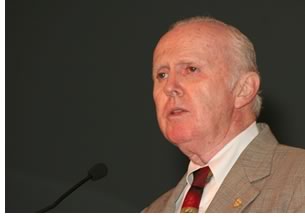 William
Henry, president of the American Society of Civil Engineers, served as
moderator for the LRRC’s November 10 Infrastructure Basics
panel. “All too often it takes a tragedy to make us stand up and
take notice of these systems,” he said. “We’ve grown
complacent—we expect these systems to work.” He reminded
the participants that the most recent National Society of Professional
Engineers “report
card” gave
the nation’s infrastructure a “solid D.” Events like
the hurricane remind us just how vulnerable our infrastructure is, he
said.
William
Henry, president of the American Society of Civil Engineers, served as
moderator for the LRRC’s November 10 Infrastructure Basics
panel. “All too often it takes a tragedy to make us stand up and
take notice of these systems,” he said. “We’ve grown
complacent—we expect these systems to work.” He reminded
the participants that the most recent National Society of Professional
Engineers “report
card” gave
the nation’s infrastructure a “solid D.” Events like
the hurricane remind us just how vulnerable our infrastructure is, he
said.
Henry defined a set of principles for the recovery effort:
- Sustainable development means providing resources now and in the future. “We need to take a more comprehensive approach to rebuilding infrastructure,” he said. “It needs to consider the effect of one system’s failure on all other systems, as well as a life-cycle cost.”
- We must consider the environmental impact of infrastructure systems.
- To manage risk more effectively, lessons learned must be used in future rebuilding, balancing probability of occurrence with acceptability of consequences.
- Infrastructure design requires sound economic analysis.
- Infrastructure design needs to encompass appropriate use of technologies and materials so that the community gets the best value for its dollar.
 Ecosystem restoration is key: “We must set the stage for building,
rebuilding, and creating a sustainable future,” declared Lt. General
(Ret.) Robert B. Flowers, former chief of engineers of the U.S. Army
Corps of Engineers. “Ecosystem restoration and the role of the
ecosystem in mitigating future impacts are necessary and key aspects
of the solution.” We have lessons and experiences in this country
from which we have learned, Flowers said, even though they don’t
match the magnitude of destruction caused by these hurricanes. The general
stressed the importance of speaking with one voice: “Competing
plans will cause confusion and likely result in reduced funding from
Congress,” he said. “Friction among federal, state, and local
groups will diminish efforts.” Also, public and private groups
must work together, according to Flowers. “Our nation has a very
short attention span. There is a need for a shared vision quickly.” He
also emphasized the need for a “simple plan that is easily understood
by all. Clarity counts.”
Ecosystem restoration is key: “We must set the stage for building,
rebuilding, and creating a sustainable future,” declared Lt. General
(Ret.) Robert B. Flowers, former chief of engineers of the U.S. Army
Corps of Engineers. “Ecosystem restoration and the role of the
ecosystem in mitigating future impacts are necessary and key aspects
of the solution.” We have lessons and experiences in this country
from which we have learned, Flowers said, even though they don’t
match the magnitude of destruction caused by these hurricanes. The general
stressed the importance of speaking with one voice: “Competing
plans will cause confusion and likely result in reduced funding from
Congress,” he said. “Friction among federal, state, and local
groups will diminish efforts.” Also, public and private groups
must work together, according to Flowers. “Our nation has a very
short attention span. There is a need for a shared vision quickly.” He
also emphasized the need for a “simple plan that is easily understood
by all. Clarity counts.”
Flowers’ suggested priorities are:
- Create a single, coordinated planning team.
- Finalize quickly a statewide recovery plan.
- Insure simple priorities.
- Protect people and business from Category 5 hurricanes.
- Rebuild infrastructure with enhanced resistance.
- Harness private-sector resources.
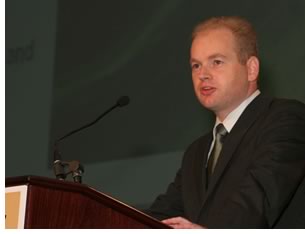 A model from the Netherlands: Dutch engineer Rene Zijlstra, who serves
as director of business for Coastal and Rivers Netherlands, offered three
principles of Dutch flood management:
A model from the Netherlands: Dutch engineer Rene Zijlstra, who serves
as director of business for Coastal and Rivers Netherlands, offered three
principles of Dutch flood management:
- Designing levees for the long term requires vision.
- Safety is not a one-time event. It requires continuous attention.
- Let nature do the job.
The Netherlands owes its existence to flood protection, Zijlstra explained. A disastrous flood in 1953, which claimed 1,800 lives, was the turning point from reactive to proactive flood management. It generated the “Delta Plan,” which took 50 years to implement. Delta Plan was developed region by region, according to the amount of risk.
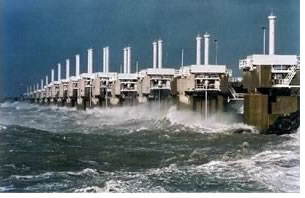 Failure of levees can be by seepage as well as overtopping, Zijlstra
reminded the audience, and all types of failures must be addressed. The
surrounding soil body also must be considered, the engineer explained
as he showed examples of different methods of flood protection that Holland
has put into place. Make sure projects are flexible, he warned.
Failure of levees can be by seepage as well as overtopping, Zijlstra
reminded the audience, and all types of failures must be addressed. The
surrounding soil body also must be considered, the engineer explained
as he showed examples of different methods of flood protection that Holland
has put into place. Make sure projects are flexible, he warned.
Zijlstra offered three principles for the participants to consider:
- Flooding results from many different causes, and each system needs to be considered with respect to all of these possibilities.
- Consider reducing the length of flood defenses.
- Flood defense systems are designed to last for a long time and must take into account developments that may occur during that period.
Finally, Zijlstra said, remember that maintenance is essential. Safety requires continuous attention, dedicated authorities, and constant attention and funding.
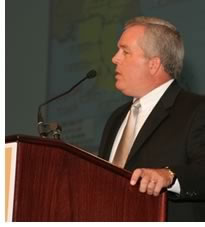 The
power company—Heroic efforts can’t prevent rising costs: Danny
Taylor, a manager of Entergy, the regional power and gas company, presented
an overview of the efforts of the company since Katrina’s
first warning signs began to appear. Of course, he said, the restoration
of service is the first priority, and people need to realize that there
are massive restoration costs. Katrina made landfall on August 28 as
a Category 4 storm and tore through 41,000 square miles. The damage in
the systems and works was the worst ever in the company’s history
with 18 transmission generators and 182 transmission lines lost, leaving
1.1 million customers without power as 80 percent of the city was underwater.
The
power company—Heroic efforts can’t prevent rising costs: Danny
Taylor, a manager of Entergy, the regional power and gas company, presented
an overview of the efforts of the company since Katrina’s
first warning signs began to appear. Of course, he said, the restoration
of service is the first priority, and people need to realize that there
are massive restoration costs. Katrina made landfall on August 28 as
a Category 4 storm and tore through 41,000 square miles. The damage in
the systems and works was the worst ever in the company’s history
with 18 transmission generators and 182 transmission lines lost, leaving
1.1 million customers without power as 80 percent of the city was underwater.
Complicating matters was the fact that the natural gas system flooded. Workers had to get the water out to make it work. Making matters worse, Entergy needed to abandon its New Orleans headquarters, and many employees lost their homes. Most were evacuated to Baton Rouge. Yet the majority “picked up their tools and went to work, like they always do,” Taylor explained. “In two weeks, 80 percent of the power was restored. Then Rita came September 25.” The upshot of the two storms is that power costs could go up 140 percent, and customers who are not returning to the city are compounding cost problems.
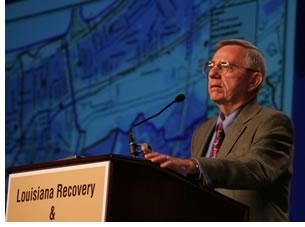 Coordinating resources: Walter Brooks, chair of the Regional Planning
Commission, explained that the commission’s extensive database
can help get a grip on effects of what happened on the regional, parish,
and project level. All of our parishes have wetlands, he explained, so
that data on soil conditions and land covers will be useful for everybody.
The commission, which is active in job programs and collects census data,
coordinates $20 million per year for regional transportation planning,
70 percent of which goes into maintenance. “We are trying to direct
federal dollars into dense projects that will maximize resources,” he
explained.”
Coordinating resources: Walter Brooks, chair of the Regional Planning
Commission, explained that the commission’s extensive database
can help get a grip on effects of what happened on the regional, parish,
and project level. All of our parishes have wetlands, he explained, so
that data on soil conditions and land covers will be useful for everybody.
The commission, which is active in job programs and collects census data,
coordinates $20 million per year for regional transportation planning,
70 percent of which goes into maintenance. “We are trying to direct
federal dollars into dense projects that will maximize resources,” he
explained.”
“We can provide extensive information on economic clusters that drive businesses in this region.” Brooks said. “We can help guide and participate in this process.” To inform the visioning process, we know what makes our neighborhoods special and we want our amenities replaced, he said. He advocated for light rail—street cars—as a catalyst to rebuilding neighborhoods. Rail transport to the airport would boost the economy as well as serve as a way to evacuate citizens if need be. “I don’t want to hear rebuild—I want to hear restore,” Brooks declared.
Copyright 2005 The American Institute of Architects.
All rights reserved. Home Page ![]()
![]()
 |
||
|
||